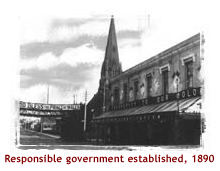|
The Western Australian Constitution and Federation In 1890 Western Australia gained representative government and its own constitution. The Western Australian Constitution Act 1889 - based on Imperial legislation enacted in the House of Commons in London - was passed by the non-democratic Legislative Council. The Act set out the form of representative parliamentary self-government to be adopted by the colony.  Since
then the Act has been amended and altered many times by the Western Australian
Parliament. The State's Constitution actually consists of those parts of
the original Act which have not been repealed and all the subsequent amendments,
most of which are embodied in another Act, the Constitution Acts Amendment
Act 1899. Because the Commonwealth Constitution was adopted in 1901,
the Western Australian Constitution makes no reference to the role of a
national government, nor to the relationship between the State and Commonwealth. Since
then the Act has been amended and altered many times by the Western Australian
Parliament. The State's Constitution actually consists of those parts of
the original Act which have not been repealed and all the subsequent amendments,
most of which are embodied in another Act, the Constitution Acts Amendment
Act 1899. Because the Commonwealth Constitution was adopted in 1901,
the Western Australian Constitution makes no reference to the role of a
national government, nor to the relationship between the State and Commonwealth.The Australian Constitution was written with the intention of defining the limited powers of a federal government. The main responsibilities given to the Commonwealth under section 51 of the Constitution related to defence and external affairs, navigation, immigration, international and interstate trade and commerce, currency, conciliation and arbitration, postal and telecommunications services, and invalid and old age pensions. The States were left with responsibility for everything else. However, over the years changes to the Constitution and changes to its interpretation have altered Commonwealth/State relations. As the Western Australian Premier, Richard Court complained in Rebuilding the Nation: An Audit and History of State Powers and Responsibilities Usurped by the Commonwealth in the Years Since Federation (1994) "the Founders intended to establish a Commonwealth Government with limited and defined powers, while leaving the States with their general plenary powers to regulate and the responsibility for the major social, economic and political concerns of Australia.While the Australian Constitution is only open to alteration through referenda which must be passed by a majority of people in a majority of States, the interpretation given to it by the High Court has changed over the years, with rulings generally favouring the Commonwealth. |
Please note: The content on this website is made available for archival purposes and may not meet the State Library of Western Australia's current standards for web accessibility, mobile device compatibility, historical accuracy and cultural sensitivity.